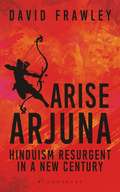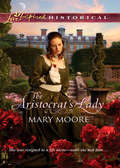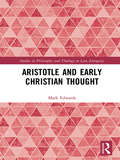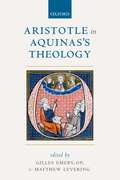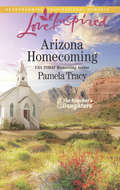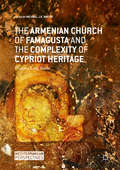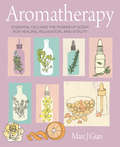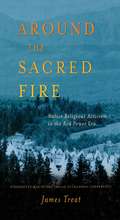- Table View
- List View
Arise Arjuna: Hinduism Resurgent in a New Century
by David FrawleyIndia faces a modern Kurukshetra as the forces of dharma and adharma clash again in a conflict that will determine the future of the nation. On one side are the forces of economic growth, cultural revival and a renewed vision of the country in harmony with its yogic values. On the other side are forces of religious prejudices, baseless propaganda, social division and materialistic political ideologies.Mere retreat, passivity or compromise cannot overcome past adversaries or the new dangers that are lurking in our conflicted media age, its invasive technology and the disruptive clash of cultures. India needs to benefit from the opportunities of the dawning knowledge era where its dharmic traditions can prosper once again. A new spiritual warrior, equipped with yogic power and Vedantic insights, is necessary like Arjuna was under the guidance of Sri Krishna. This book is a call for new Arjunas to emerge among us, learn the skills of the information age and uphold the cause of dharma with discernment and dedication on both intellectual and spiritual levels.Only through this can we awaken our spirit to uplift our world at this critical juncture of human history when the very foundations of life are threatened.
The Aristocrat's Lady (Mills And Boon Love Inspired Historical Ser.)
by Mary MooreAn Unexpected Encounter
The Aristotelian Tradition in Early Modern Protestantism: Sixteenth- and Seventeenth-Century Commentaries on the Ethics and the Politics (Oxford Studies in Historical Theology)
by Manfred SvenssonAristotle's moral and political thought formed the backbone of education in practical philosophy for centuries during the classical and medieval periods. It has often been presumed, however, that with the advent of the Protestant Reformation, this tradition was broken. Originally a topic belonging to Roman Catholic polemics, this interpretation of Protestant relations with Aristotle gradually became a part of the Protestant self-understanding as well. Lack of engagement with the actual curriculum of early Protestant schools allowed Luther's dismissive comments on Aristotle to be taken as representative of early Protestant teaching. In The Aristotelian Tradition in Early Modern Protestantism Manfred Svensson shows how the days of this view as a dominant narrative are over. Between 1529 and 1670, Protestants published around 55 commentaries on the Ethics and around 15 on the Politics, several of these in numerous editions. In academies and universities in Lutheran and Reformed territories throughout the Reformation and post-Reformation era, the exposition of these works continued to form the backbone of moral and political education. This tradition has, however, largely flown under the radar and is now for the first time presented in a comprehensive way. Offering a discussion of the medieval context and debt to Renaissance Aristotelianism, Svensson maps the relationships between these commentaries and their authors, presenting their shared understanding of practical philosophy in its relation to the Christian faith and offering in-depth discussions of key ethical and political concepts.
The Aristotelian Tradition in Early Modern Protestantism: Sixteenth- and Seventeenth-Century Commentaries on the Ethics and the Politics (Oxford Studies in Historical Theology)
by Manfred SvenssonAristotle's moral and political thought formed the backbone of education in practical philosophy for centuries during the classical and medieval periods. It has often been presumed, however, that with the advent of the Protestant Reformation, this tradition was broken. Originally a topic belonging to Roman Catholic polemics, this interpretation of Protestant relations with Aristotle gradually became a part of the Protestant self-understanding as well. Lack of engagement with the actual curriculum of early Protestant schools allowed Luther's dismissive comments on Aristotle to be taken as representative of early Protestant teaching. In The Aristotelian Tradition in Early Modern Protestantism Manfred Svensson shows how the days of this view as a dominant narrative are over. Between 1529 and 1670, Protestants published around 55 commentaries on the Ethics and around 15 on the Politics, several of these in numerous editions. In academies and universities in Lutheran and Reformed territories throughout the Reformation and post-Reformation era, the exposition of these works continued to form the backbone of moral and political education. This tradition has, however, largely flown under the radar and is now for the first time presented in a comprehensive way. Offering a discussion of the medieval context and debt to Renaissance Aristotelianism, Svensson maps the relationships between these commentaries and their authors, presenting their shared understanding of practical philosophy in its relation to the Christian faith and offering in-depth discussions of key ethical and political concepts.
Aristotle and Early Christian Thought (Studies in Philosophy and Theology in Late Antiquity)
by Mark EdwardsIn studies of early Christian thought, ‘philosophy’ is often a synonym for ‘Platonism’, or at most for ‘Platonism and Stoicism’. Nevertheless, it was Aristotle who, from the sixth century AD to the Italian Renaissance, was the dominant Greek voice in Christian, Muslim and Jewish philosophy. Aristotle and Early Christian Thought is the first book in English to give a synoptic account of the slow appropriation of Aristotelian thought in the Christian world from the second to the sixth century. Concentrating on the great theological topics – creation, the soul, the Trinity, and Christology – it makes full use of modern scholarship on the Peripatetic tradition after Aristotle, explaining the significance of Neoplatonism as a mediator of Aristotelian logic. While stressing the fidelity of Christian thinkers to biblical presuppositions which were not shared by the Greek schools, it also describes their attempts to overcome the pagan objections to biblical teachings by a consistent use of Aristotelian principles, and it follows their application of these principles to matters which lay outside the purview of Aristotle himself. This volume offers a valuable study not only for students of Christian theology in its formative years, but also for anyone seeking an introduction to the thought of Aristotle and its developments in Late Antiquity.
Aristotle and Early Christian Thought (Studies in Philosophy and Theology in Late Antiquity)
by Mark EdwardsIn studies of early Christian thought, ‘philosophy’ is often a synonym for ‘Platonism’, or at most for ‘Platonism and Stoicism’. Nevertheless, it was Aristotle who, from the sixth century AD to the Italian Renaissance, was the dominant Greek voice in Christian, Muslim and Jewish philosophy. Aristotle and Early Christian Thought is the first book in English to give a synoptic account of the slow appropriation of Aristotelian thought in the Christian world from the second to the sixth century. Concentrating on the great theological topics – creation, the soul, the Trinity, and Christology – it makes full use of modern scholarship on the Peripatetic tradition after Aristotle, explaining the significance of Neoplatonism as a mediator of Aristotelian logic. While stressing the fidelity of Christian thinkers to biblical presuppositions which were not shared by the Greek schools, it also describes their attempts to overcome the pagan objections to biblical teachings by a consistent use of Aristotelian principles, and it follows their application of these principles to matters which lay outside the purview of Aristotle himself. This volume offers a valuable study not only for students of Christian theology in its formative years, but also for anyone seeking an introduction to the thought of Aristotle and its developments in Late Antiquity.
Aristotle in Aquinas's Theology
by Gilles Emery, O.P. Matthew LeveringAristotle in Aquinas's Theology explores the role of Aristotelian concepts, principles, and themes in Thomas Aquinas's theology. Each chapter investigates the significance of Aquinas's theological reception of Aristotle in a central theological domain: the Trinity, the angels, soul and body, the Mosaic law, grace, charity, justice, contemplation and action, Christ, and the sacraments. In general, the essays focus on the Summa theologiae, but some range more widely in Aquinas's corpus. For some time, it has above all been the influence of Aristotle on Aquinas's philosophy that has been the centre of attention. Perhaps in reaction to philosophical neo-Thomism, or perhaps because this Aristotelian influence appears no longer necessary to demonstrate, the role of Aristotle in Aquinas's theology presently receives less theological attention than does Aquinas's use of other authorities (whether Scripture or particular Fathers), especially in domains outside of theological ethics. Indeed, in some theological circles the influence of Aristotle upon Aquinas's theology is no longer well understood. Readers will encounter here the great Aristotelian themes, such as act and potency, God as pure act, substance and accidents, power and generation, change and motion, fourfold causality, form and matter, hylomorphic anthropology, the structure of intellection, the relationship between knowledge and will, happiness and friendship, habits and virtues, contemplation and action, politics and justice, the best form of government, and private property and the common good. The ten essays in this book engage Aquinas's reception of Aristotle in his theology from a variety of points of view: historical, philosophical, and constructively theological.
Aristotle in Aquinas's Theology
Aristotle in Aquinas's Theology explores the role of Aristotelian concepts, principles, and themes in Thomas Aquinas's theology. Each chapter investigates the significance of Aquinas's theological reception of Aristotle in a central theological domain: the Trinity, the angels, soul and body, the Mosaic law, grace, charity, justice, contemplation and action, Christ, and the sacraments. In general, the essays focus on the Summa theologiae, but some range more widely in Aquinas's corpus. For some time, it has above all been the influence of Aristotle on Aquinas's philosophy that has been the centre of attention. Perhaps in reaction to philosophical neo-Thomism, or perhaps because this Aristotelian influence appears no longer necessary to demonstrate, the role of Aristotle in Aquinas's theology presently receives less theological attention than does Aquinas's use of other authorities (whether Scripture or particular Fathers), especially in domains outside of theological ethics. Indeed, in some theological circles the influence of Aristotle upon Aquinas's theology is no longer well understood. Readers will encounter here the great Aristotelian themes, such as act and potency, God as pure act, substance and accidents, power and generation, change and motion, fourfold causality, form and matter, hylomorphic anthropology, the structure of intellection, the relationship between knowledge and will, happiness and friendship, habits and virtues, contemplation and action, politics and justice, the best form of government, and private property and the common good. The ten essays in this book engage Aquinas's reception of Aristotle in his theology from a variety of points of view: historical, philosophical, and constructively theological.
Arizona Homecoming: Trusting The Cowboy The Single Dad's Redemption Arizona Homecoming (The Rancher's Daughters #3)
by Pamela TracyBuilding on Love
An Ark on the Nile: Beginning of the Book of Exodus
by Keith BodnerThe opening sector of the book of Exodus is a powerful narrative and a striking example of the artistic qualities of the Pentateuch, a facet of the text that occasionally is neglected in high-level scholarship. Exodus 1-2 is finely choreographed work that compresses a vast amount of material onto a limited textual canvas, creating a story that appeals to readers of every age. Resuming where the book of Genesis leaves off-the last image of Genesis 50 is a coffin in Egypt, primed for a sequel-the first two chapters of Exodus combine a fast-moving plot with some unique shades of characterization: Israel's growth in Egypt, the rise of a malevolent new king, the birth of a hero and early experiences of adversity for the main character in the story to come. The burden of slavery and miracle of salvation are introduced in this sector of text, and become paradigmatic examples of divine redemption that reverberate throughout the Hebrew Bible and beyond. An Ark on the Nile: The Beginning of the Book of Exodus is a close-reading of Exodus 1-2 that analyzes the story as a reasonably self-contained unit, but suggesting that major plot movements in the book of Exodus are foreshadowed and anticipated here. Applying a number of insights from literary theory, Keith Bodner offers an illustration of further integration of biblical studies with cross-disciplinary narrative interpretation.
An Ark on the Nile: Beginning of the Book of Exodus
by Keith BodnerThe opening sector of the book of Exodus is a powerful narrative and a striking example of the artistic qualities of the Pentateuch, a facet of the text that occasionally is neglected in high-level scholarship. Exodus 1-2 is finely choreographed work that compresses a vast amount of material onto a limited textual canvas, creating a story that appeals to readers of every age. Resuming where the book of Genesis leaves off-the last image of Genesis 50 is a coffin in Egypt, primed for a sequel-the first two chapters of Exodus combine a fast-moving plot with some unique shades of characterization: Israel's growth in Egypt, the rise of a malevolent new king, the birth of a hero and early experiences of adversity for the main character in the story to come. The burden of slavery and miracle of salvation are introduced in this sector of text, and become paradigmatic examples of divine redemption that reverberate throughout the Hebrew Bible and beyond. An Ark on the Nile: The Beginning of the Book of Exodus is a close-reading of Exodus 1-2 that analyzes the story as a reasonably self-contained unit, but suggesting that major plot movements in the book of Exodus are foreshadowed and anticipated here. Applying a number of insights from literary theory, Keith Bodner offers an illustration of further integration of biblical studies with cross-disciplinary narrative interpretation.
Armenian Christianity Today: Identity Politics and Popular Practice
by Alexander AgadjanianArmenian Christianity Today examines contemporary religious life and the social, political, and cultural functions of religion in the post-Soviet Republic of Armenia and in the Armenian Diaspora worldwide. Scholars from a range of countries and disciplines explore current trends and everyday religiosity, particularly within the Armenian Apostolic Church (AAC), and amongst Armenian Catholics, Protestants and vernacular religions. Themes examined include: Armenian grass-roots religiosity; the changing forms of regular worship and devotion; various types of congregational life; and the dynamics of social composition of both the clergy and lay believers. Exploring through the lens of Armenia, this book considers wider implications of ’postsecular’ trends in the role of global religion.
Armenian Christianity Today: Identity Politics and Popular Practice
by Alexander AgadjanianArmenian Christianity Today examines contemporary religious life and the social, political, and cultural functions of religion in the post-Soviet Republic of Armenia and in the Armenian Diaspora worldwide. Scholars from a range of countries and disciplines explore current trends and everyday religiosity, particularly within the Armenian Apostolic Church (AAC), and amongst Armenian Catholics, Protestants and vernacular religions. Themes examined include: Armenian grass-roots religiosity; the changing forms of regular worship and devotion; various types of congregational life; and the dynamics of social composition of both the clergy and lay believers. Exploring through the lens of Armenia, this book considers wider implications of ’postsecular’ trends in the role of global religion.
The Armenian Church of Famagusta and the Complexity of Cypriot Heritage: Prayers Long Silent
by Michael J.K. WalshThis book explores seven centuries of change in Cyprus and the Eastern Mediterranean world through the rise and fall of Famagusta’s medieval Armenian Church. An examination of the complex and its art escorts the reader from the era of the Crusades in Lusignan Cyprus, through the rise and fall of the Venetian, Ottoman and British Empires, to the political stasis of the present day. The Armenian church was a home for displaced villagers during the post-independence era, became a military storage facility post-1974 and eventually fell into abandonment once again. This study represents a pioneering history of the Armenian community in Famagusta and a probing analysis of the art and architecture it left behind. It is also a permanent record of the long-term engagement and commitment of Nanyang Technological University Singapore, the World Monuments Fund, and the Famagusta Municipality to protect this precious site, under extremely challenging circumstances.
The Armenian Church of Famagusta and the Complexity of Cypriot Heritage: Prayers Long Silent
by Michael J.K. WalshThis book explores seven centuries of change in Cyprus and the Eastern Mediterranean world through the rise and fall of Famagusta’s medieval Armenian Church. An examination of the complex and its art escorts the reader from the era of the Crusades in Lusignan Cyprus, through the rise and fall of the Venetian, Ottoman and British Empires, to the political stasis of the present day. The Armenian church was a home for displaced villagers during the post-independence era, became a military storage facility post-1974 and eventually fell into abandonment once again. This study represents a pioneering history of the Armenian community in Famagusta and a probing analysis of the art and architecture it left behind. It is also a permanent record of the long-term engagement and commitment of Nanyang Technological University Singapore, the World Monuments Fund, and the Famagusta Municipality to protect this precious site, under extremely challenging circumstances.
The Armenian Gospel of the Infancy: with three early versions of the Protevangelium of James
The various versions of the Infancy Gospels illustrate how stories about the Virgin and Child lend themselves to be told and retold - much like the stories in the canonical Gospels. This first translation of the full text of the Armenian Gospel of the Infancy, itself derived from a sixth-century Syriac text that no longer exists, provides two variants of the famous narrative and several recensions or ancient editions. Stories about Jesus, many of them unique to this gospel, are included to show how he exercised his sovereign and divine will even as a child. This edition also contains three early Armenian versions of the Protevangelium of James, which with other ancient sources dependent on it (like the Infancy Gospel of Thomas and the Gospel of Pseudo-Matthew) constitute the basic tradition in the formation of the later Infancy Gospels. These writings are our earliest sources about the parents of the Virgin Mary (Joachim and Anne) and her miraculous birth. They also form the basis for the dogma of her Immaculate Conception and perpetual virginity after the birth of Jesus, and lay the ground for certain of the Marian feasts celebrated since the fourth century. Terian's engaging introduction and annotation of the texts place this rare document clearly in its cultural and historical context and provide extensive references to the surrounding textual tradition. These extraordinary stories will appeal to all with an interest in the early church.
Aromatherapy
by Marc J. GianIn Aromatherapy you will find the foundations for harnessing this power and self-healing with essential oils. Learn about oils such as peppermint, lavender, rose, eucalyptus and many more.
Around the Sacred Fire: Native Religious Activism in the Red Power Era
by J. TreatAround the Sacred Fire is a compelling cultural history of intertribal activism centered on the Indian Ecumenical Conference, an influential movement among native people in Canada and the U.S. during the Red Power era. Founded in 1969, the Conference began as an attempt at organizing grassroots spiritual leaders who were concerned about the conflict between tribal and Christian traditions throughout Indian country. By the mid-seventies thousands of people were gathering each summer in the foothills of the Rockies, where they participated in weeklong encampments promoting spiritual revitalization and religious self-determination. Most historical overviews of native affairs in the sixties and seventies emphasize the prominence of the American Indian Movement and the impact of highly publicized confrontations such as the Northwest Coast fish-ins, the Alcatraz occupation, and events at Wounded Knee. The Indian Ecumenical Conference played a central role in stimulating cultural revival among native people, partly because Conference leaders strategized for social change in ways that differed from the militant groups. Drawing on archival records, published accounts, oral histories, and field research, James Treat has written the first comprehensive study of this important but overlooked effort at postcolonial interreligious dialogue.
Art, Allegory and the Rise of Shi’ism in Iran, 1487-1565
by Chad KiaTransforming our understanding of Persian art, this impressive interdisciplinary book decodes some of the world’s most exquisite medieval paintings. It reveals the hidden meaning behind enigmatic figures and scenes that have puzzled modern scholars, focusing on five ‘miniature’ paintings. Chad Kia shows how the cryptic elements in these works of art from Timurid Persia conveyed the mystical teachings of Sufi poets like Rumi, Attar and Jami, and heralded one of the most significant events in the history of Islam: the takeover by the Safavids in 1501 and the conversion of Iran to Shiism.
Art and Architecture in the Islamic Tradition: Aesthetics, Politics and Desire in Early Islam (Library of Modern Middle East Studies)
by Mohammed Hamdouni AlamiWhat is 'art' in the sense of the Islamic tradition? Mohammed Hamdouni Alami argues that Islamic art has historically been excluded from Western notions of art; that the Western aesthetic tradition's preoccupation with the human body has meant that Islamic and Western art being perceived as inherently at odds. However, the move away from this 'anthropomorphic aesthetic' in Western art movements, such as modern abstract and constructivist painting, have presented the opportunity for new ways of viewing and evaluating Islamic art and architecture. Drawing upon classical Arabic literature, philosophy, poetry, medicine and theology, along with contemporary Western art theory, the author uncovers a specific Islamic theoretical vision of art and architecture based on poetic practice, politics, desire and the 'gaze'. In so doing, he addresses the lack of recognition given to early Islamic thought and aesthetics in comparison with other historical periods and traditions. This is an important step toward a critical analysis of the contemporary debate around the revival of Islamic architectural identity- debate intricately embedded within opposing Islamic political and social projects throughout the world.
Art and Architecture of the World's Religions [2 volumes]: [2 volumes]
by Leslie D. RossTwo abundantly illustrated volumes offer a vibrant discussion of how the divine is and has been represented in art and architecture the world over.Beginning with the ancient worlds of Mesopotamia, Egypt, Greece, and Rome and moving forward through time, Art and Architecture of the World's Religions explores the major faiths from countries and continents around the globe, helping readers better understand the creations their beliefs have inspired. After tracing the history and development of a religion, the book provides a general overview of its principal beliefs and key practices. It then offers specific examples of how works of art/architecture reflect that religion's values.The focus of each chapter is on the temples, churches, and religious buildings, statues, paintings, and other works of art and architecture created by believers. Each representative work of art or architecture is examined in terms of its history, materials, symbols, colors, and patterns, as its significance is explained to the reader. With extensive illustrations, these volumes are the definitive reference work on art and architecture of the world's religions.
Art and Faith: A Theology of Making
by Makoto FujimuraFrom a world-renowned painter, an exploration of creativity’s quintessential—and often overlooked—role in the spiritual life Written over thirty years of painting and creating in his studio, this book is Makoto Fujimura’s broad and deep exploration of creativity and the spiritual aspects of “making.” What he does in the studio, he asserts, is theological work as much as it is aesthetic work. In between pouring precious, pulverized minerals onto handmade paper to create the prismatic, refractive surfaces of his art, he comes into the quiet space in the studio, in a discipline of awareness, waiting, prayer, and praise. Ranging from the Bible to T. S. Eliot, and from Mark Rothko to Japanese Kintsugi technique, he shows how unless we are making something, we cannot know the depth of God’s being and God’s grace permeating our lives. This poignant and beautiful book offers the perspective of, in Christian Wiman’s words, “an accidental theologian,” one who comes to spiritual questions always through the prism of art.
The Art and Material Culture of Iranian Shi'ism: Iconography and Religious Devotion in Shi'i Islam
by Pedram KhosronejadThe official religion of Iran has been Shi'i Islam from the Safavids in the sixteenth century to the present day. Little is known about the material culture produced, especially in Iran, by the narratives and traditions surrounding Shi'ism. The Shi'i world experience has provided a rich artistic tradition encompassing painting, sculpture and the production of artefacts and performance. This tradition has helped to distinguish Shi'ism from Sunni Islam, and to embed Shi'i identity in Iran as part of its national narrative.Numerous studies have focused on aspects of Shi'ism and culture in Iran: on the Muharram rituals, the ta'ziyeh plays, Shi'i theology and the post-revolutionary politics of Shi'i Iran. However, few look at the relationship of Shi'ism to art or to material culture in Iran more widely. This is the first thorough examination of the art and material culture of Iranian Shi'ism within each of its political, religious and cultural dimensions. Pedram Khosronejad brings together highly distinguished scholars in the field to trace the ways in which Shi'i rule and theology have interacted with the architecture, art and material culture of Iran since the sixteenth century.The Art and Material Culture of Iranian Shi'ism reveals the variety of forms in which Shi'ism has produced popular arts in Iran. It addresses questions such as: in what areas of material culture has Iranian Shi'ism manifested itself through objects or buildings that are unique within the overall culture of Islam? To what extent is the art and architecture of Iran from the Safavid period onwards identifiably Shi'i, and what does this say about the relationship of nation, state and faith in Iran?This is an original contribution with a highly interdisciplinary approach that will appeal to all with scholarly interest in the history and culture of Iran and Shi'ism. The book will also be immensely valuable within the fields of Middle East and Islamic studies more broadly – whether from the perspectives of history, politics, religion or the history of art.
Art and Meaning: Rhetoric in Biblical Literature (The Library of Hebrew Bible/Old Testament Studies)
by Alan J. Hauser David J. Clines David M. GunnBiblical authors were artists of language who created their meaning through their verbal artistry, their rhetoric. These twelve essays see meaning as ultimately inseparable from art and seek to understand the biblical literature with sensitivity to the writer's craft. Contents: David Clines, The Arguments of Job's Friends. George Coats, A Moses Legend in Numbers 12. Charles Davis, The Literary Structure of Luke 1-2. Cheryl Exum, A Literary Approach to Isaiah 28. David Gunn, Plot, Character and Theology in Exodus 1-14. Alan Hauser, Intimacy and Alienation in Genesis 2-3. Charles Isbell, Story Lines and Key Words in Exodus 1-2. Martin Kessler, Methodology for Rhetorical Criticism. John Kselman, A Rhetorical Study of Psalm 22. Kenneth Kuntz, Rhetorical Criticism and Isaiah 51.1-16. Ann Vater, Form and Rhetorical Criticism in Exodus 7-11. Edwin Webster, Pattern in the Fourth Gospel.
